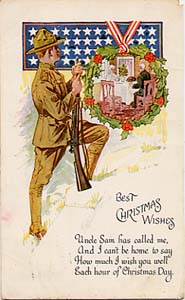A Few American Publishers
- A.M. Davis Company: Boston. Published many early American flats. Later purchased by Rust Craft.
Learn more about A.M. Davis Company BY CLICKING HERE
- Rust Craft: Kansas City and Boston. Developed the French Fold card, and led the industry
in many areas of production.
Learn more about Rust Craft BY CLICKING HERE
- Hallmark Cards: Kansas City. Beginning with only two shoeboxes of postcards, Joyce C. Hall built an
empire in the greeting card industry.
Learn more about Hallmark Cards BY CLICKING HERE
- Gibson Art Company: Cincinnati. Beginning with just a few Christmas designs in 1908 Gibson grew
rapidly and became the largest manufacture of its kind in the country.
Learn more about Gibson Art Company BY CLICKING HERE
- Buzza: Minneapolis. Founded by George Buzza in 1909, a man of ideas and insight to new
and unique designs.
Learn more about The Buzza Company BY CLICKING HERE
World War I Era Cards
Christmas card designs over time have featured the
lifestyles of their times, as well as traditional themes. They have been a
reflection of our social life, habits, pastimes, dress, and inventions.
After the turn of the century Christmas cards began to have zeppelins,
aeroplanes and motorcars on them. Sail ships gave way to steamers. During
war times battleships were featured on Christmas cards.
Prior to WWI most Christmas cards were of German import. With the outbreak
of war the market was closed to German imports. This gave American companies
like Hall Brothers, A.M. Davis, Buzza, Gibson, and Rust Craft the opportunity
to fill the shelves and develop into well-established publishers. Wartime
and the spirit of Christmas are at two opposite ends of emotions and feelings.
These card publishers had to be very sensitive at how to express the
wishes of the season when people were being separated and thrust into the
horrors of war.
The sending of Christmas cards during WWI was at first banned for security
reasons and to conserve paper "for the war effort". But it was later
encouraged by the government as a way to help boost the morale of the
troops and publishers were rationed paper for this purpose. Cards sent at
Christmas, the loneliest time to be away from home, became a symbol of
hope for both sender and receiver; a hope for peace. However, economizing
was important to many people and they considered Christmas cards a luxury
and could be done without. Instead, parcels were sent to the front until
they were bared to conserve shipping facilities for military needs.
 During WWI the mood of Christmas cards changed from the decadence of the
Edwardian period to more simple designs. Many cards had a patriotic
theme and were embellished with red, white, and blue ribbons or cords.
Doughboys appeared on postcards, which had just peaked in popularity.
Some regiments issued their own cards for soldiers to send back home.
Those soldiers on the front lines and in the trenches didn't always have
an opportunity to send a printed card, so they hand drew sketches of
themselves, camp scenes or holiday scenes and sent those home. Unfortunately,
many of the cards produced during the war were pulped for "the war effort",
so there aren't too many that survived this period.
During WWI the mood of Christmas cards changed from the decadence of the
Edwardian period to more simple designs. Many cards had a patriotic
theme and were embellished with red, white, and blue ribbons or cords.
Doughboys appeared on postcards, which had just peaked in popularity.
Some regiments issued their own cards for soldiers to send back home.
Those soldiers on the front lines and in the trenches didn't always have
an opportunity to send a printed card, so they hand drew sketches of
themselves, camp scenes or holiday scenes and sent those home. Unfortunately,
many of the cards produced during the war were pulped for "the war effort",
so there aren't too many that survived this period.
The postcard on the right is postmarked 1918. It expresses a soldier's
sentimate to loved ones back home.
"Best Christmas Wishes
Uncle Sam has called me,
And I can't be home to say
How much I wish you well
Each hour of Christmas Day."
The card was published by Illustrated Postal card & Nov. Co. N.Y.
After the war, sales of cards slumped, especially patriotic cards, as
people wanted to put the war as far behind them as possible. There was a
trend instead towards reproducing famous paintings. The quality of cards
increased and were of higher artistic standard.
Page 8